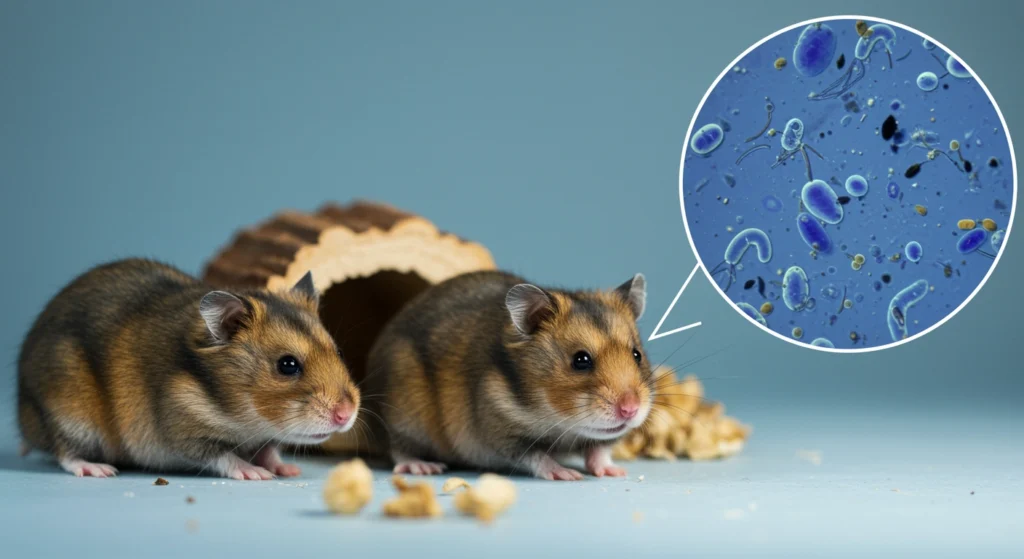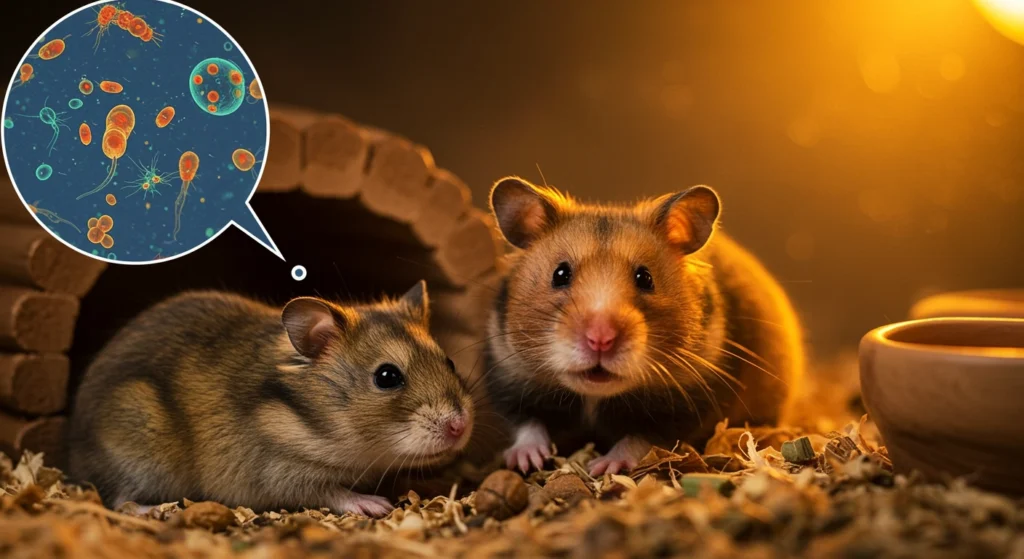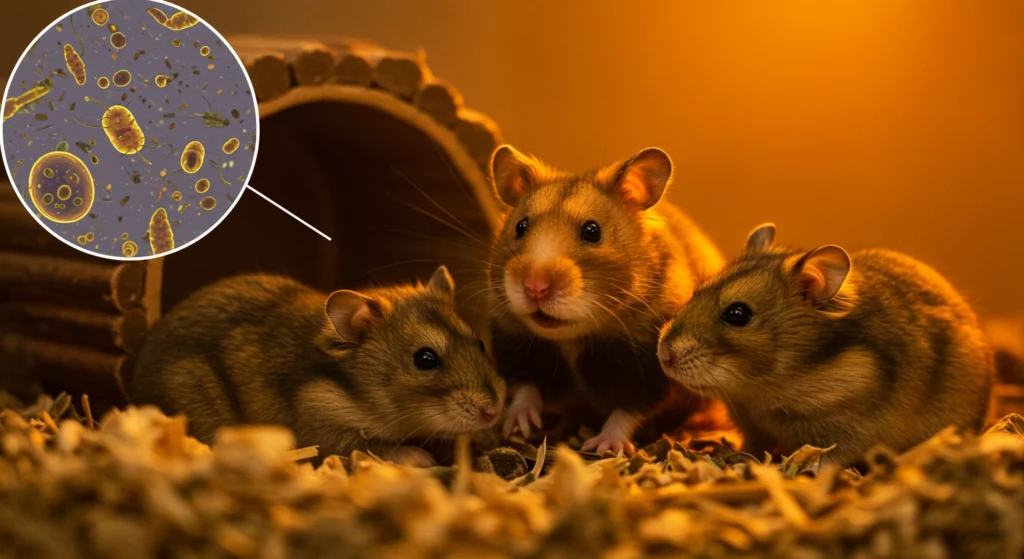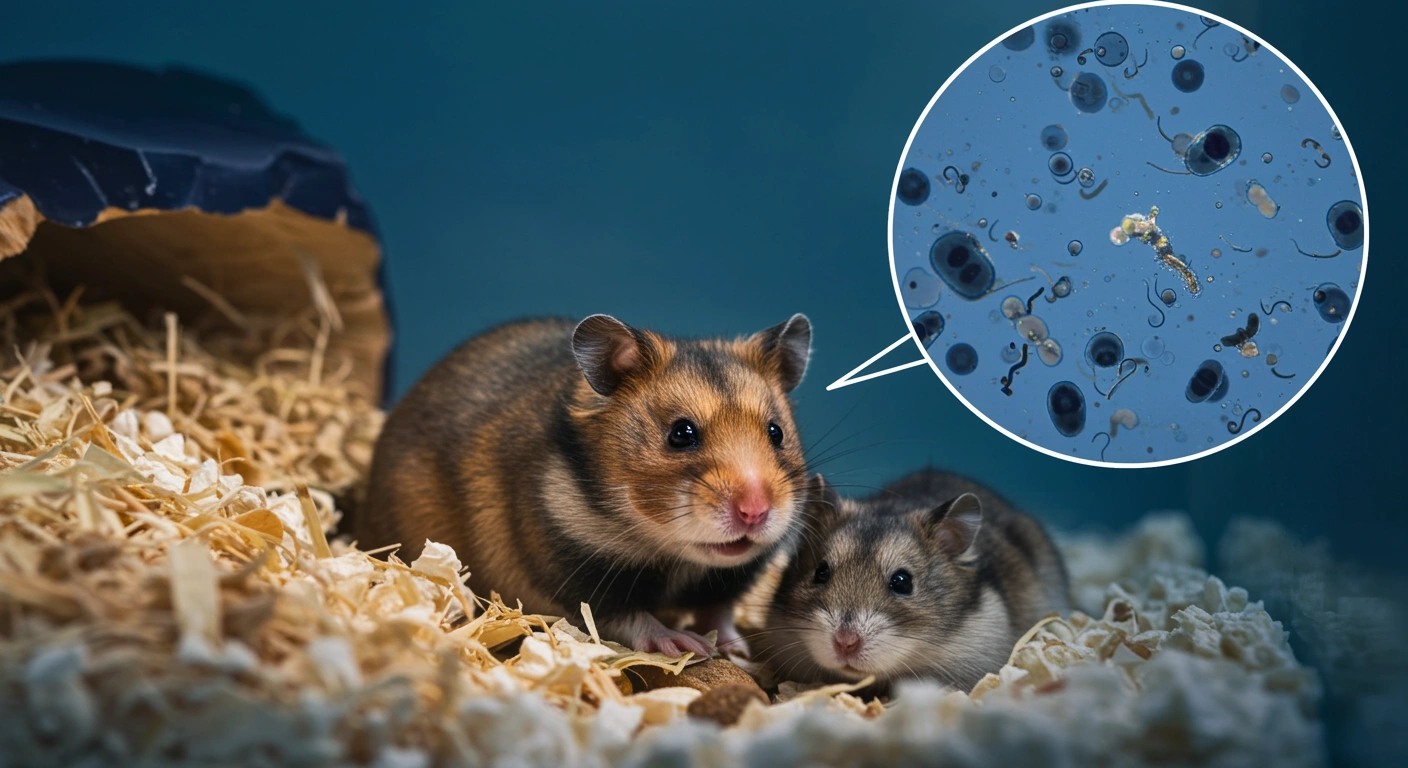Discover the 6 key warning signs of parasites in rodents and learn effective early treatment strategies to keep your pet healthy and parasite-free.
Rodents, from pet hamsters to wild mice, are susceptible to a variety of parasitic infections that can significantly impact their health and wellbeing. Whether you’re a devoted pet owner or dealing with wild rodents on your property, understanding the early warning signs of parasites in rodents is crucial for prompt intervention. These tiny invaders can cause severe health complications if left untreated, potentially leading to weight loss, behavioral changes, and even death in severe cases. This comprehensive guide explores the most common parasites in rodents, how to identify an infestation early, and the most effective treatment options available today. By recognizing these warning signs, you can protect your pet rodents from unnecessary suffering and prevent potential spread to other animals or humans in your household.

Table of Contents

Understanding Parasites in Rodents
What Are Rodent Parasites?
Parasites in rodents encompass a diverse group of organisms that live on or inside rodent hosts, deriving nutrients at the expense of their hosts’ health. These unwanted guests can be broadly classified into two main categories: ectoparasites (external) and endoparasites (internal).
Ectoparasites live on the outside of the rodent’s body and include:
- Mites
- Fleas
- Ticks
- Lice
Endoparasites reside inside the rodent’s body and include:
- Roundworms
- Tapeworms
- Pinworms
- Protozoa (single-celled organisms)
According to recent veterinary studies, over 70% of wild rodents harbor at least one type of parasite, while approximately 15-20% of pet rodents will experience a parasitic infection at some point in their lives. This high prevalence makes parasite awareness an essential aspect of rodent health management.
Common Parasites That Affect Rodents
Understanding the specific parasites that commonly affect rodents can help in early identification and treatment. Here’s a detailed look at the most prevalent parasites in rodents:
External Parasites (Ectoparasites)
- Fur Mites (Myobia musculi, Myocoptes musculinus)
- Microscopic arthropods that live in the fur and on the skin
- Particularly common in mice, rats, and hamsters
- Can cause intense itching and skin irritation
- Fleas (Ctenocephalides spp.)
- Small, jumping insects that feed on blood
- Can transmit diseases between rodents and to humans
- Most common in wild rodents but can affect pets too
- Ticks (Ixodes spp.)
- Blood-feeding arachnids that attach to the skin
- More common in wild rodents than pets
- Can transmit serious diseases like Lyme disease
- Lice (Polyplax spp.)
- Small, wingless insects that live in the fur
- Feed on blood and skin debris
- Can cause significant skin irritation and hair loss
Internal Parasites (Endoparasites)
- Pinworms (Syphacia obvelata, Aspiculuris tetraptera)
- Small, white worms that primarily inhabit the large intestine
- Particularly common in mice and rats
- Can cause rectal irritation and digestive issues
- Tapeworms (Hymenolepis spp.)
- Flat, segmented worms that live in the intestines
- Usually transmitted through ingestion of infected fleas or other insects
- Can cause weight loss and nutritional deficiencies
- Roundworms (Nippostrongylus spp.)
- Cylindrical worms that inhabit the intestinal tract
- Often transmitted through contaminated food or water
- Can cause significant digestive problems and poor growth
- Protozoan Parasites (Giardia, Cryptosporidium, Spironucleus)
- Single-celled organisms that affect the digestive system
- Transmitted through contaminated water or food
- Can cause severe diarrhea and dehydration
Recent research published in the Journal of Veterinary Parasitology indicates that climate change and increased globalization have contributed to changing parasite distribution patterns, with some parasites expanding their traditional geographic ranges and affecting previously unaffected rodent populations.

6 Signs of Parasite Infestations in Rodents
Early detection of parasites in rodents is crucial for effective treatment and prevention of serious health complications. Here are the six key signs that your rodent may be suffering from a parasitic infestation:
1. Visible External Parasites or Evidence
One of the most straightforward signs of an ectoparasite infestation is the visual detection of the parasites themselves or evidence of their presence.
What to look for:
- Small moving specs in the fur (mites or lice)
- Tiny brown or black insects jumping on or around the rodent (fleas)
- Small, dark, seed-like specks in bedding or around the cage (flea dirt/feces)
- Attached ticks on the skin (especially around ears, neck, and tail base)
A 2023 study in the American Journal of Veterinary Medicine found that regular visual inspections can detect up to 65% of ectoparasite infestations before they cause significant health issues. When examining your rodent, use good lighting and consider a magnifying glass for better visibility of smaller parasites like mites.
2. Unusual Scratching, Biting, or Grooming Behavior
Parasites in rodents often cause intense itching or discomfort, leading to noticeable changes in grooming habits and self-care behaviors.
Behavioral indicators:
- Excessive scratching, particularly focused on specific areas
- Increased grooming frequency or intensity
- Self-biting or nibbling at the skin
- Rubbing against cage items to relieve itching
- Agitation or restlessness, especially after periods of rest
These behaviors are particularly common with mite, flea, and lice infestations, which directly irritate the skin. According to veterinary behaviorists, parasite-related scratching tends to be more persistent and intense than normal grooming behaviors, often continuing until the rodent causes self-injury.
3. Changes in Coat Appearance and Skin Condition
Parasitic infestations frequently manifest as visible changes to a rodent’s coat and skin health, making this an important indicator to monitor.
Physical signs to watch for:
- Hair loss (alopecia), particularly around the shoulders, back, and tail base
- Rough, dull, or unkempt fur appearance
- Reddened, inflamed, or scaly skin
- Small red bumps or rashes
- Crusty or scabby patches
- Visible skin flaking or dandruff-like appearance
A comprehensive study by the European Veterinary Dermatology Association revealed that 78% of rodents with parasitic infestations showed noticeable coat changes within two weeks of initial infestation. Regular handling and inspection of your pet rodent allows for early detection of these changes before they become severe.
4. Weight Loss and Changes in Appetite
Internal parasites in particular can significantly impact a rodent’s nutritional status and metabolism, leading to observable changes in body condition and eating habits.
Nutritional and body condition changes:
- Unexplained weight loss despite normal food consumption
- Failure to gain weight in young rodents
- Swollen or distended abdomen (potbelly appearance)
- Increased appetite without weight gain
- Decreased interest in food
- Changes in food preferences
Veterinary nutritionists note that endoparasites like tapeworms and roundworms compete for nutrients in the rodent’s digestive system, leading to malnutrition even when the animal is eating normal amounts. According to recent clinical data, weight loss exceeding 10% of body weight within a two-week period strongly suggests a potential parasite problem and warrants immediate veterinary attention.
5. Gastrointestinal Symptoms
The digestive system is a primary target for many internal parasites, resulting in various gastrointestinal symptoms that can serve as important warning signs.
Digestive indicators:
- Diarrhea or soft stools
- Visible blood or mucus in feces
- Constipation or straining to defecate
- Rectal prolapse (in severe cases)
- Visible worms or worm segments in feces
- Changes in stool color or consistency
- Increased frequency of defecation
Research published in the Journal of Rodent Medicine indicates that approximately 60% of rodents with internal parasitic infections develop noticeable gastrointestinal symptoms within 3-4 weeks of infestation. Monitoring your rodent’s droppings can provide valuable early warning signs, as changes in stool consistency often precede other more serious symptoms.
6. Behavioral and Energy Level Changes
Parasitic infestations can significantly impact a rodent’s overall well-being, leading to observable changes in behavior and activity levels.
Behavioral indicators:
- Lethargy or reduced activity
- Decreased interest in exploration or play
- Irritability or aggression
- Hiding more than usual
- Changes in sleeping patterns
- Reduced social interaction with cage mates or human handlers
- General depression or listlessness
Veterinary behaviorists emphasize that these behavioral changes result from both the physical discomfort caused by parasites and the metabolic impact of the infestation. A 2022 study in Applied Animal Behaviour Science found that behavioral changes were present in 83% of rodents with significant parasite burdens, often appearing before severe physical symptoms developed.
Diagnosis of Parasites in Rodents
When to Consult a Veterinarian
While some signs of parasites in rodents may be observable at home, proper diagnosis often requires professional veterinary expertise. Consider consulting a veterinarian who specializes in exotic or small pets when:
- Your rodent displays multiple symptoms mentioned above
- Symptoms persist for more than 48-72 hours
- Your rodent shows signs of severe discomfort or distress
- You observe rapid weight loss or severe lethargy
- Home treatments haven’t improved the condition within a week
- Multiple rodents in the same environment show similar symptoms
- You’re concerned about potential zoonotic parasites (those that can spread to humans)
According to the Association of Exotic Mammal Veterinarians, early veterinary intervention for parasitic infections can reduce treatment time by up to 60% and significantly improve outcomes.
Diagnostic Methods
Veterinarians employ several diagnostic techniques to identify and confirm the presence of parasites in rodents:
- Physical Examination
- Visual inspection of coat, skin, and body condition
- Assessment of hydration status and vital signs
- Examination of mucous membranes and lymph nodes
- Fecal Testing
- Direct smear examination: Immediate examination of fresh fecal material
- Flotation tests: Concentration techniques to identify parasite eggs
- Baermann technique: Specifically for certain larvae detection
- Skin Scrapings and Fur Samples
- Microscopic examination of skin cells and debris
- Identification of mites, lice, or eggs
- Assessment of secondary bacterial infections
- Blood Tests
- Complete blood count to assess for anemia or elevated white blood cells
- Biochemical profiles to evaluate organ function
- Specialized tests for certain blood parasites
- Advanced Imaging (in complex cases)
- Ultrasound to assess internal organs
- Radiographs to identify complications or severe infestations
Recent advances in rodent diagnostics include PCR-based testing, which can identify parasitic DNA with greater accuracy than traditional methods. A 2023 study in Veterinary Parasitology demonstrated that molecular diagnostics can detect parasite presence up to 10 days earlier than conventional testing methods.
Treatment Options for Rodent Parasites
Veterinary Treatments
Professional veterinary treatments offer the most effective and targeted approach to eliminating parasites in rodents:
- Antiparasitic Medications
- Ivermectin: Effective against many mites, lice, and some internal parasites
- Fenbendazole: Primarily used for intestinal worms
- Praziquantel: Specifically targets tapeworms
- Selamectin: Broad-spectrum treatment for multiple parasites
- Administration Methods
- Oral medications (often mixed with food)
- Injectable treatments (for severe cases)
- Topical solutions (for some ectoparasites)
- Medicated baths (in specific situations)
- Treatment Protocols
- Most treatments require multiple doses
- Follow-up testing to confirm parasite elimination
- Environmental treatment may be prescribed simultaneously
According to the Journal of Small Exotic Animal Medicine, veterinary-prescribed treatments have a 85-95% success rate when administered correctly and completely. Always follow the prescribed regimen exactly, even if symptoms appear to resolve before treatment is finished.
Home Care and Management
While professional veterinary care is essential for treating parasites in rodents, proper home care plays a crucial role in recovery and prevention of reinfestation:
- Environmental Cleaning
- Complete cage cleaning and disinfection
- Replacement of all bedding materials
- Washing of all toys, hideaways, and accessories
- Regular ongoing cleaning during treatment period
- Quarantine Procedures
- Separation of affected rodents from healthy ones
- Dedicated feeding and handling equipment for infected animals
- Proper hand hygiene between handling different animals
- Nutritional Support
- High-quality diet to support immune function
- Easily digestible foods for rodents with GI symptoms
- Supplemental feeding if weight loss is significant
- Fresh water availability at all times
- Monitoring Recovery
- Daily weight checks
- Observation of behavior and activity levels
- Stool quality assessment
- Documentation of symptom improvement or worsening
A study in the International Journal of Veterinary Medicine found that comprehensive home care during parasite treatment improved recovery rates by 40% compared to medication alone, highlighting the importance of this complementary approach.
Natural and Preventive Approaches
While natural remedies should not replace veterinary treatment for confirmed parasitic infestations, certain preventive measures and supportive approaches can complement conventional treatments:
- Preventive Habitat Management
- Regular cage cleaning (complete cleaning weekly)
- Daily spot cleaning of soiled areas
- Proper ventilation and humidity control
- Quarantine of new rodents before introduction to existing pets
- Diet Considerations
- Fresh, high-quality food sources
- Proper food storage to prevent contamination
- Avoidance of wild plants or untreated water sources
- Limited treats to maintain optimal nutrition
- Stress Reduction
- Appropriate habitat enrichment
- Consistent daily routines
- Minimal environmental disruptions
- Proper socialization for social species
- Complementary Approaches
- Diatomaceous earth (food grade) in bedding (for some ectoparasites)
- Probiotic supplements (to support gut health during recovery)
- Immune-supporting nutrients like vitamin C for guinea pigs
Recent research in preventive veterinary medicine indicates that implementing comprehensive preventive measures can reduce the risk of parasitic infections in pet rodents by up to 70%. However, natural approaches should be discussed with a veterinarian to ensure they are safe and appropriate for your specific rodent species.
Prevention of Parasite Infestations
Regular Health Monitoring
Consistent monitoring is the cornerstone of early parasite detection and prevention:
- Scheduled Health Checks
- Weekly physical examinations including:
- Coat and skin inspection
- Weight monitoring
- Behavior assessment
- Fecal consistency check
- Monthly more thorough examinations
- Biannual veterinary wellness exams
- Weekly physical examinations including:
- Record Keeping
- Tracking weight trends over time
- Documenting any concerning symptoms
- Maintaining treatment records
- Noting behavioral or appetite changes
According to the American Exotic Pet Veterinary Association, rodent owners who perform regular health checks identify potential parasite issues an average of 12 days earlier than those who don’t, significantly improving treatment outcomes.
Habitat Management
Proper habitat management significantly reduces the risk of parasite infestations:
- Cleaning Protocols
- Complete habitat cleaning every 5-7 days
- Daily spot cleaning of soiled areas
- Washing of food and water containers daily
- Regular disinfection of toys and accessories
- Bedding Considerations
- Use of appropriate bedding materials (paper-based or aspen)
- Avoiding cedar or pine shavings (which can cause respiratory issues)
- Sufficient bedding depth for natural behaviors
- Complete bedding replacement during cleanings
- Environmental Factors
- Proper temperature maintenance (65-75°F for most species)
- Appropriate humidity levels (30-50%)
- Adequate ventilation without drafts
- Protection from wild rodent access
A longitudinal study published in Laboratory Animal Science demonstrated that implementing strict habitat management protocols reduced parasite prevalence by 83% in a controlled rodent population over a two-year period.
Quarantine Practices
Quarantine procedures are essential for preventing the introduction of parasites to existing rodent populations:
- New Pet Quarantine
- Separation of new rodents for a minimum of 3-4 weeks
- Housing in a different airspace from existing pets
- Use of dedicated handling and feeding equipment
- Observation for any signs of illness or parasites
- Post-Treatment Isolation
- Continued separation of treated animals until parasite-free status confirmed
- Complete habitat disinfection before reintroduction
- Gradual reintroduction to minimize stress
- Show or Event Protocols
- Quarantine after returning from exhibitions or pet shows
- Careful monitoring for 2-3 weeks after external exposure
- Preventive habitat cleaning upon return
Veterinary parasitologists recommend these measures based on the incubation periods of common rodent parasites, which can range from 5 days to 3 weeks before visible symptoms appear.
Zoonotic Concerns: When Rodent Parasites Affect Humans
Some parasites that affect rodents can also pose health risks to humans, making awareness of these zoonotic parasites particularly important:
Common Zoonotic Parasites
- Rat Mite (Ornithonyssus bacoti)
- Can cause dermatitis in humans
- Typically causes itchy red papules similar to mosquito bites
- Usually self-limiting once the rodent infestation is addressed
- Rodent Tapeworms (Hymenolepis spp.)
- Can infect humans who accidentally ingest eggs
- More common with wild rodent exposure
- May cause digestive symptoms in infected individuals
- Giardia and Cryptosporidium
- Protozoan parasites that can affect multiple species
- Transmitted through contaminated water or fecal exposure
- Cause diarrhea and digestive upset in humans
Prevention of Zoonotic Transmission
To minimize the risk of human infection from rodent parasites:
- Hygiene Practices
- Thorough handwashing after handling rodents or cleaning habitats
- Use of gloves when cleaning cages or handling visibly affected animals
- Keeping rodent habitats away from food preparation areas
- Regular disinfection of surfaces where rodents are handled
- Education and Awareness
- Teaching children proper animal handling and hygiene
- Understanding transmission routes for common zoonotic parasites
- Recognition of potential symptoms in humans
- Prompt Treatment
- Immediate veterinary care for affected rodents
- Medical consultation if family members develop unexplained skin rashes or digestive symptoms after rodent exposure
According to the Centers for Disease Control and Prevention, proper hygiene practices can reduce the risk of zoonotic disease transmission by over 90%, making this a critical aspect of responsible rodent ownership.
Recommended Pet Products on Amazon
Effective Tools for Parasite Prevention and Treatment
- Kaytee Clean & Cozy White Small Animal Bedding
- Highly absorbent paper bedding that helps maintain a clean environment
- Dust-free formula reduces respiratory irritation
- White color makes parasite detection easier during routine checks
- Oxbow Animal Health Natural Science Vitamin C Supplement
- Supports immune function in guinea pigs and other rodents
- Helps maintain resilience against parasitic infections
- Easy-to-administer tablet form for consistent supplementation
- Ware Manufacturing Small Animal Habitat Sanitation Spray
- Pet-safe disinfectant for habitat surfaces and accessories
- Helps eliminate parasite eggs and disease-causing organisms
- Effective between deep cleanings for maintaining hygiene
- Vetericyn Plus All Animal Wound and Skin Care
- Gentle antimicrobial spray for skin irritations caused by parasites
- Promotes healing of scratches and irritated areas
- Safe if ingested during grooming
Frequently Asked Questions About Parasites in Rodents
Common Concerns and Expert Answers
Q: How often should I check my pet rodent for parasites?
A: Perform a basic visual inspection weekly during regular handling sessions. Look for changes in coat appearance, skin condition, and behavior. More thorough checks, including examining droppings and weighing your pet, should be conducted monthly. Professional veterinary examinations are recommended every 6-12 months for preventive health care.
Q: Can all rodent parasites be seen with the naked eye?
A: No, many common rodent parasites, particularly mites and some internal parasites, are microscopic and cannot be seen without magnification. Instead of seeing the actual parasites, you’ll often notice their effects: skin irritation, hair loss, scratching behavior, or changes in droppings. Some larger parasites like adult roundworms may be visible in feces, and flea dirt might be noticeable in the bedding.
Q: Is it safe to treat my rodent for parasites without a veterinary diagnosis?
A: Self-diagnosis and treatment are not recommended. Many parasite treatments are species-specific and dosage-sensitive, with potentially toxic effects if used incorrectly. What appears to be a parasitic infection might also be another condition with similar symptoms. A veterinary diagnosis ensures the correct treatment for the specific parasite and appropriate dosing for your rodent’s species and weight.
Q: How long does it take to eliminate parasites in rodents?
A: Treatment duration varies depending on the parasite type, infestation severity, and treatment method. Most treatment protocols require 2-4 weeks of medication, with some requiring repeat doses to address parasite life cycles. Complete resolution, including healing of secondary skin issues, may take 4-6 weeks. Follow-up testing is often necessary to confirm that all parasites have been eliminated.
Q: Can wild rodents near my home infect my pet rodents with parasites?
A: Yes, wild rodents can be a source of parasites for pet rodents if there’s direct or indirect contact. Parasites can transfer through shared ventilation systems, on clothing, or when wild rodents access the same spaces. Keep pet rodents in secure enclosures, maintain good sanitation, and implement pest control measures to minimize wild rodent presence near pet habitats.
Q: Are certain rodent species more susceptible to particular parasites?
A: Yes, parasite susceptibility varies among rodent species. For example, fur mites (Myobia musculi) primarily affect mice, while Demodex caviae mites specifically target guinea pigs. Rats are particularly susceptible to certain lice species. Understanding the common parasites that affect your specific rodent species allows for more targeted monitoring and preventive measures.
Learning More About Rodent Health and Care
Understanding parasites in rodents is just one aspect of comprehensive rodent care. To expand your knowledge and provide the best possible care for your pet rodents, explore more pet care tips and guides on blithepet . Their expert recommendations cover nutrition, habitat design, behavioral enrichment, and health maintenance for various rodent species.
By staying informed about the latest developments in small animal care, you can ensure your rodent companions live healthy, comfortable lives free from parasitic infestations and their associated health problems.
Conclusion
Parasites in rodents represent a significant health concern that requires vigilance, early detection, and appropriate treatment. By understanding the six key signs of parasite infestations—visible parasites, unusual scratching, coat changes, weight loss, gastrointestinal symptoms, and behavioral changes—rodent owners can intervene promptly and effectively.
Professional veterinary care remains the cornerstone of parasite treatment, with a variety of medication options available for different parasite types. Complementing this medical approach with proper home care, habitat management, and preventive practices creates a comprehensive strategy for maintaining parasite-free rodents.
Remember that some rodent parasites can affect humans, making proper hygiene and handling practices essential for both animal and human health. Regular monitoring, consistent habitat maintenance, and quarantine protocols significantly reduce the risk of initial infestations and reinfestation after treatment.
Have you dealt with parasites in your pet rodents? Share your experience and the strategies that worked best for you in the comments below!



